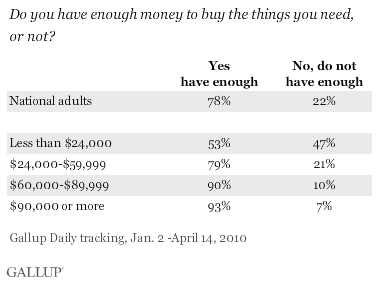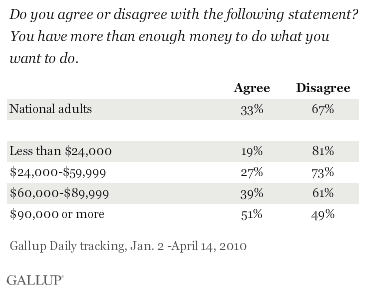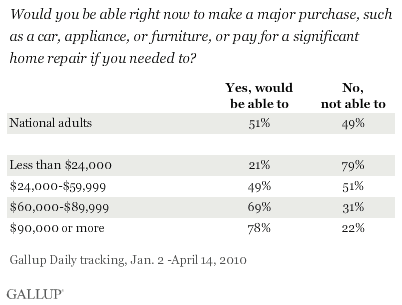PRINCETON, NJ -- Having enough money to "buy the things you need" is a strong correlate of Americans' broad perception of their own wellbeing. Overall, 60% of Americans who say they have enough money for their needs rate their lives well enough to be considered "thriving." By contrast, 27% of those who can't meet their needs are thriving. This pattern is generally seen at each income level.
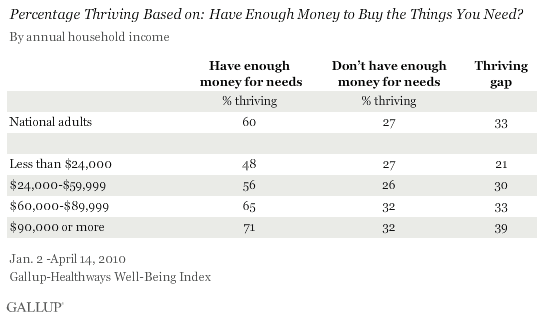
Meeting ones' needs is one thing; satisfying desires is another, and Gallup measures this by asking Americans whether they have "more than enough money to do what you want to do." Although the rate of those who are thriving increases significantly among Americans who say they can afford to do what they want, it is also fairly high among those who cannot, particularly at upper-income levels.
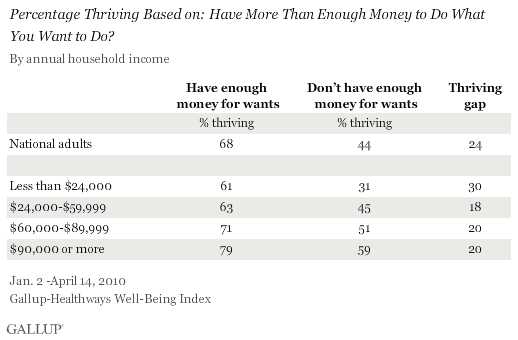
Confidence in one's ability to make a major purchase falls between ability to pay for needs and wants in its relationship to thriving. The majority of Americans at every income who say right now they would be able to make a major purchase are personally thriving. However, so are substantial numbers -- as high as 53% among the highest income group -- of those who can't make such a purchase.
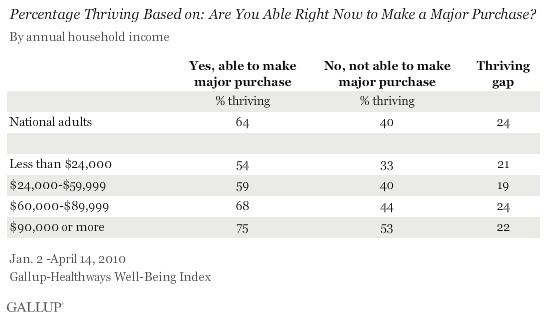
These findings are from Gallup tracking thus far in 2010 (from January-April 14). The Gallup-Healthways Well-Being Index classifies Americans as either "thriving," "struggling," or "suffering," according to how they rate their current and future lives on a 0-to-10 ladder scale based on the Cantril Self-Anchoring Striving Scale.
While providing for one's basic needs, feeling able to make major purchases, and fulfilling one's desires all relate to positive wellbeing, other dimensions of Americans' financial lives are less connected. For instance, most Americans (89%) say they are watching their spending very closely, but at every income level this bears little relation to the percentage who are thriving. Those who expressly say they are cutting back on their spending -- 72% of Americans right now -- report moderately lower thriving scores than those who are not cutting back.
Bottom Line
Affording the basics in life is not just the starting point of financial success; for many, it's the goal, and a satisfying one to boot. Other factors may be responsible for pushing the thriving percentages much closer to 100% for Americans of different income levels, but the data suggest the contentment that comes from being able to pay one's bills, buy groceries, put gas in the car, and possibly have a few dollars leftover may help make a majority of Americans in households earning more than $24,000 feel positively about their overall wellbeing.
Learn more about the Gallup-Healthways Well-Being Index.
Survey Methods
Results are based on telephone interviews with a random sample of more than 12,000 national adults, aged 18 and older, conducted between Jan. 2 and April 14, 2010, as part of Gallup Daily tracking. For results based on the total sample of national adults, one can say with 95% confidence that the maximum margin of sampling error is ±1 percentage points.
The Life Evaluation Index is based on the Cantril Self-Anchoring Striving Scale, which asks people to evaluate their present and future lives on a scale with steps numbered from 0 to 10, where "0" is the worst possible life and "10" is the best possible life. Those who rate today a "7" or higher and the future an "8" or higher are considered to be "thriving." Those who rate today and the future a "4" or lower on the scale are considered to be "suffering." The overall Life Evaluation Index score is calculated as the percentage of thriving Americans minus the percentage of suffering Americans.
Interviews are conducted with respondents on landline telephones (for respondents with a landline telephone) and cellular phones (for respondents who are cell phone only).
In addition to sampling error, question wording and practical difficulties in conducting surveys can introduce error or bias into the findings of public opinion polls.
About the Gallup-Healthways Well-Being Index™
The Gallup-Healthways Well-Being Index measures the daily pulse of U.S. wellbeing and provides best-in-class solutions for a healthier world. To learn more, please visit well-beingindex.com.
